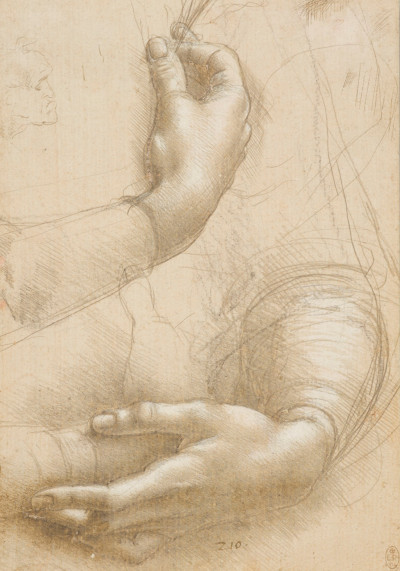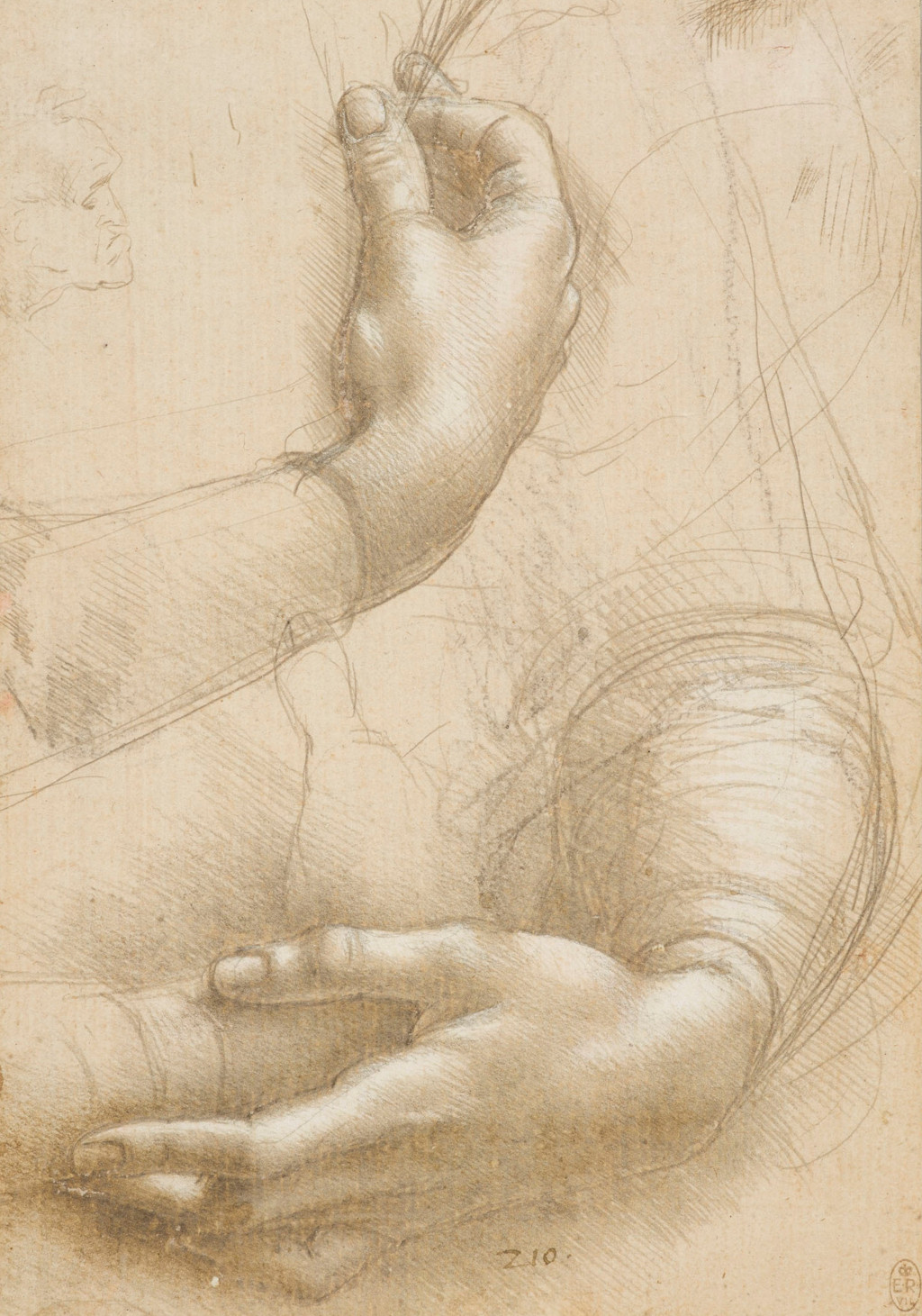Study of Hands is a Leonardo da Vinci drawing dated to around 1474-1490. It features various anatomical studies together on the same piece of prepared paper.
Introduction
Leonardo was a highly accomplished draughtsman and these skills, developed and honed over a period of several decades, would lay the foundation to all his work, across multiple disciplines. Sketches such as this also help to remind us of his insight into the human body, and his incredible attention to detail.
Whilst the artist is regularly termed a genius, this label would ignore the incredible amounts of time and energy that he put into developing his craft. Whilst his inherent brilliance brought about innovations in painting techniques, architecture and science, he was also particularly hard working, enthusiastic and curious.
The Study of Hands, sometimes known as "Sheet of Studies of Hands and Arms", shows the artist preparing for a later portrait, using every inch of the paper for various drawings of varying levels of detail. Most of the great masters would work in this manner, filling every inch of paper with a collection of sometines unrelated studies.
For many centuries, Leonardo was only known as a painter, and it has only been relatively recently that the focus on his achievements has spread to encompass all of the other disciplines in which he was involved. Experts have gone through his drawings in great detail, attempting to connect them to later paintings, as well as to understand more about his methods and stages of production, from initial sketch to fully fledged painting.
The artist would sketch for many different reasons throughout his lifetime, but in the case of Study of Female Hands, it is highly likely that this was a preparation piece for his highly respected secular portrait, titled Ginevra de' Benci, which continues to be regarded as one of his finest paintings, though this remains disputed.
With the interest in Da Vinci's drawings continuing to grow, you will find many more sketches from his career included elsewhere in this website, covering the full breadth of subjects, from inventions, science, anatomical studies, portraits and even some loose landscapes. There are also studies of botany as well, as this Renaissance great continued to broaden his horizons as far as possible.
This article examines Leonardo's Study of Hands in detail, dissecting the composition into its various parts and then speculating on why the artist decided to put this collection of sketches together. We also explain where this original artwork can be found today, and how you might view it in person. There is also some discussion around other anatomical studies by the artist, and the types of mediums that he used for these tasks.
Table of Contents
- Introduction
- Description
- Location
- Date
- Size and Medium
- Provenance
- Famous Drawings and Paintings of Hands
- Large Image of the Study of Hands Drawings
- References
Description
Leonardo da Vinci's Study of Hands from the 1470s (possibly later) features two well formed hands, along with outlines of other elements. There is a small portrait in the top left that most people miss on first glance, and the arms and sleeves attached to the hands are left as approximate shapes.
The main focus is therefore on the long arm which hangs down, with a left hand stretching across the bottom of the drawing. It holds the loose outline of a right hand within it. An additional hand is then sketched out above, and the two completed elements are clearly connected.
Despite arriving early on in the artist's career, we can immediately tell from this Study of Hands that Leonardo has already mastered this genre to a high level. The precision delivered to the hands is extraordinary, with beautifully accurate tones which look almost lifelike. Da Vinci was a subtle, highly skilled master who would always attempt to produce images which resembled reality, with the individual lines of pencil or brush to be hidden from our eyes.
Location
Leonardo da Vinci's Study of Hands can be found in the Royal Collection, based in the United Kingdom. It has been there since around 1690, having been acquired by Charles II.
The permanent collection includes over one thousand drawings from Leonardo alone, making it one of the largest displays of his work, anywhere in the world. It would not be possible to show all of these items at the same time, and so loans are commonly organised, and some of the less significant pieces are kept in storage.
Date
This study of two female hands has been attributed several different dates by a variety of art historians. The most likely period would be between 1474-1490, with most scholars believing it was produced in the mid to late 1470s. Its present owners, however, have suggested a much later date of 1490.
Drawings by the old masters have typically gone undocumented and have also often been damaged, leading to difficulties for art historians who observe these pieces several centuries later. Da Vinci would pass his sketches around his studio in order to help others to follow in his artistic style, and so these items were not treated as valuable artworks in the way in which they are today.
We are therefore left with considerable guess work in dating this drawing accurately, and much would depend on any connection with other paintings, for which this could have been a early study. Da Vinci's portrait of Ginevra de' Benci came in 1474–1478, and most historians believe that this was a preparation for this artwork, which explains why many give a similar date to the drawing too.
This connection has been complicated by how the portrait itself was cropped at the bottom, meaning the hands and arms have since been removed - making it harder to conclusively prove that this Study of Hands was indeed a preparation for the later portrait.
"...The style of the drawing is however significantly later than that painting, with a combination of strong searching outlines and rapid but controlled parallel hatching, characteristic of Leonardo’s metalpoint drawings of around 1490..."
Royal Collection
As seen in the quote above, the Royal Collection believe that the techniques shown in this piece are more in line with the artist's use of metal point in 1490, and so have dated the drawing at around then - thus losing its connection to the earlier portrait of Ginevra de Benci.
Size and Medium
Leonardo's Study of Hands was produced using a combination of silverpoint with white highlights, on a piece of prepared paper which measures 8.43 x 5.91 inches. The white highlights were used to increase the variations in tone, helping to produce the lifelike qualities found in both hands.
He would apply the white elements in order to give the impression of light falling across the hands, and would add it to the higher parts, suggesting that light was falling from above. The balance of light was a key ingredient to the artist's success as a painter, and he practiced some of these effects within his drawings, having spent time observing these effects in reality.
The current owners of the drawing, The Royal Collection, have listed the item as also containing the use of charcoal, and they also have listed the paper used for this drawing as being "pale pinkish-buff, prepared". Such a prestigious institution as this would be able to make use of highly skilled experts and researchers who would not only be able to preserve this piece for future generations, but also to reveal many new secrets about it through a variety of modern research techniques.
Provenance
This study of female hands is believed to have passed into the Royal Collection as early as 1690. It would have been purchased by Charles II from Thomas Howard, 14th Earl of Arundel. Previously it had passed through several private collections in Italy, having originally been bequethed to Francesco Melzi. It is rare to be able to trace a Leonardo artwork as conclusively as this, particularly a drawing.
Famous Drawings and Paintings of Hands
Such is his prominence within art history, Leonardo da Vinci's Study of Female Hands is one of the most famous hand studies. The human anatomy has attracted considerable study over the centuries and even the finest artists have realised the necessity of practice for this challenging genre.
Perhaps two artworks which could be considered even more famous than this would be Michelangelo's Creation of Adam, in which two fingers join together in a symbolic moment. There is also Albrecht Durer's Praying Hands which is compositionally and stylistically relatively similar to Da Vinci's own contribution here. All three of these great masters would leave behind pages and pages of studies, with different limbs and head portraits strewn across every spare spot of the paper.
Large Image of the Study of Hands Drawings
This intricate drawing is best served by the larger, higher resolution image which is included below of Leonardo da Vinci's Study of Hands. This remains amongst his most famous study drawings, and he left behind many anatomical studies from a long and varied career. His skills as a draughtsman would lay the foundations to his success in all other disciplines, such as painting, architecture and invention.
References
- Leonardo. The Complete Paintings and Drawings, Frank Zöllner & Johannes Nathan, Taschen
- Leonardo da Vinci, Walter Isaacson





